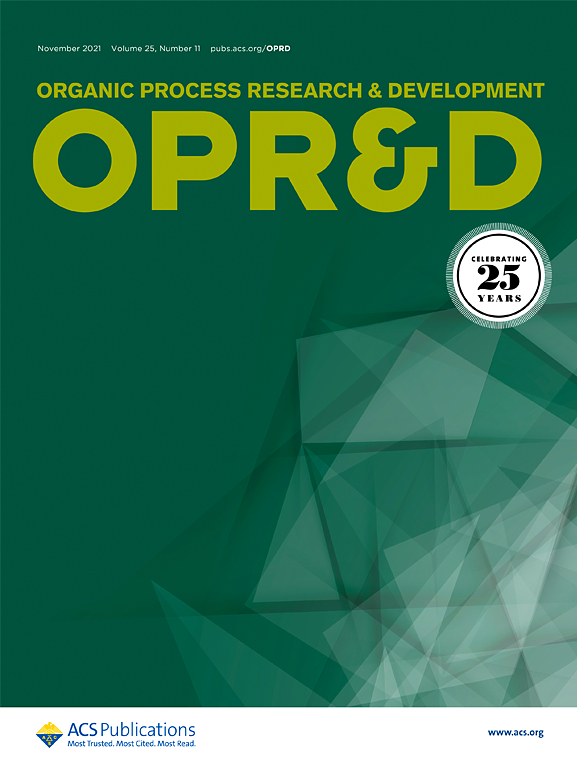连续流光氧化还原胺合成的机器学习驱动优化
IF 3.5
3区 化学
Q2 CHEMISTRY, APPLIED
引用次数: 0
摘要
光氧化还原催化在药物相关化合物如富含C(sp3)叔胺的合成中起着重要作用。识别这种新转化的潜在机制模型的困难,加上这类反应的大反应空间,意味着开发一个健壮的过程是具有挑战性的。在这项工作中,我们展示了机器学习驱动的光氧化还原叔胺合成优化,其中六个连续变量(例如,浓度,温度,停留时间)和溶剂选择作为离散变量,在半自动连续流设置中。从一个大型溶剂库开始,工作流包括先验知识生成的多个步骤(例如,溶解度预测)以缩小离散空间。然后,采用一种新的贝叶斯优化算法,即游牧探索性多目标优化(NEMO),来确定和填充两个反应目标(产量和反应成本)的帕累托前沿。排列特征重要性图和部分依赖性图确定了高收率的最重要参数,sig3,离散空间的s形不对称,以及连续变量的烯烃和Hantzsch酯当量。催化剂负载和停留时间与吸收光子当量有关,催化剂负载是驱动成本的主要参数。尽管生产效率不是优化目标,但在流动中获得的最佳结果比批量反应高~ 25倍,相当于每天生产~ 12 g。本文章由计算机程序翻译,如有差异,请以英文原文为准。
Machine Learning-Driven Optimization of Continuous-Flow Photoredox Amine Synthesis
Photoredox catalysis plays an important role in the synthesis of pharmaceutically relevant compounds such as C(sp3)-rich tertiary amines. The difficulty of identifying underlying mechanistic models for such novel transformations, coupled with the large reaction space of this reaction class, means that developing a robust process is challenging. In this work, we demonstrate the machine learning-driven optimization of a photoredox tertiary amine synthesis with six continuous variables (e.g., concentration, temperature, residence time) and solvent choice as a discrete variable, in a semiautomated continuous flow setup. Starting with a large library of solvents, the workflow included multiple steps of a priori knowledge generation (e.g., solubility predictions) to narrow the discrete space. A novel Bayesian optimization algorithm, nomadic exploratory multiobjective optimization (NEMO), was then deployed to identify and populate the Pareto front for the two reaction objectives─yield and reaction cost. Permutation feature importance and partial dependence plots identified the most important parameters for high yield, sig3, the asymmetry of the s-profile for the discrete space, and equivalences of alkene and Hantzsch ester for the continuous variables. Catalyst loading and residence time were found to be correlated to absorbed photon equivalence, while catalyst loading was additionally the main parameter to drive cost. Even though productivity was not an optimization objective, the best result achieved in flow was ∼25 times higher than reactions in batch, which equals to ∼12 g per day throughput.
求助全文
通过发布文献求助,成功后即可免费获取论文全文。
去求助
来源期刊
CiteScore
6.90
自引率
14.70%
发文量
251
审稿时长
2 months
期刊介绍:
The journal Organic Process Research & Development serves as a communication tool between industrial chemists and chemists working in universities and research institutes. As such, it reports original work from the broad field of industrial process chemistry but also presents academic results that are relevant, or potentially relevant, to industrial applications. Process chemistry is the science that enables the safe, environmentally benign and ultimately economical manufacturing of organic compounds that are required in larger amounts to help address the needs of society. Consequently, the Journal encompasses every aspect of organic chemistry, including all aspects of catalysis, synthetic methodology development and synthetic strategy exploration, but also includes aspects from analytical and solid-state chemistry and chemical engineering, such as work-up tools,process safety, or flow-chemistry. The goal of development and optimization of chemical reactions and processes is their transfer to a larger scale; original work describing such studies and the actual implementation on scale is highly relevant to the journal. However, studies on new developments from either industry, research institutes or academia that have not yet been demonstrated on scale, but where an industrial utility can be expected and where the study has addressed important prerequisites for a scale-up and has given confidence into the reliability and practicality of the chemistry, also serve the mission of OPR&D as a communication tool between the different contributors to the field.

 求助内容:
求助内容: 应助结果提醒方式:
应助结果提醒方式:


